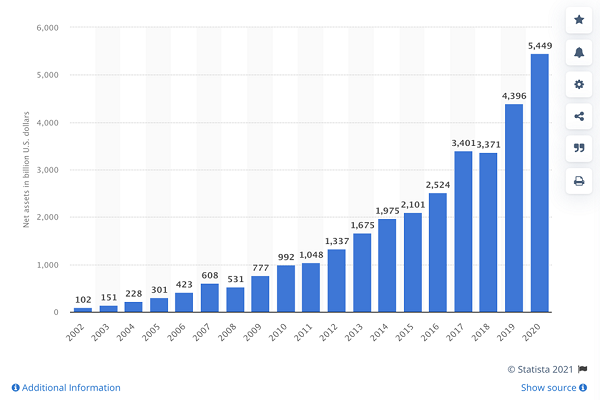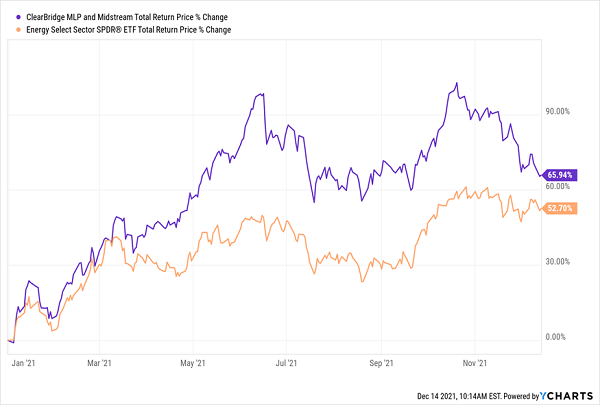Let’s be honest: we dividend investors will be glad to see the back of 2021. While it’s been a great year for us at my CEF Insider service (our portfolio yields 7.2%, on average, and we’ve seen some nice double-digit winners, too), it seems like every day begins with a market-crushing (and anxiety-inducing!) news story.
To be honest, 2022 will likely bring much of the same, but if you do what I strongly recommend—stay away from the business news as much as possible—you’ll do your portfolio (and your mental health!) a big favor.
You and I both know the pundits rarely get it right anyway (who remembers the hand-wringing worries about deflation 12 months ago? Or a housing-market crash?). And worse, they almost always miss the things that are really important.
Like the fact that high-yield closed-end funds (CEFs) are a much better option than ETFs for investors looking for income. Yet most folks have no clue: last year, they piled more money into ETFs than ever!
CEFs’ Weaker Sisters Attract First-Level Investors, Dribble Out Lousy Payouts

Compare the $5.5 trillion in assets above to the microscopic $244 billion sitting in CEFs now. It represents a missed opportunity for those misguided ETF investors, and one we CEF investors are more than happy to capitalize on!
To get at what I’m talking about, consider the two best-performing sectors of the market in 2021: energy and real estate investment trusts (REITs).
Energy CEF Crushes Its ETF Cousin, Yields an Outsized 7.3%
Let’s start with energy, whose massive gains are seen in the Energy Select Sector SPDR® Fund (NYSE:XLE), which has jumped 53% so far in 2021 (the ETF yields 3.9% as I write this). But a comparable CEF did much better—and handed its investors a much bigger slice of their return in cash, too!
That CEF would be the Clearbridge Energy MLP Closed Fund (NYSE:CEM), which mostly holds master limited partnerships (MLPs)—companies that operate oil and gas pipelines. Big-name players in the space, like Enterprise Products Partners (NYSE:EPD), ONEOK (NYSE:OKE), and Energy Transfer LP (NYSE:ET), populate its top holdings.
It wasn’t even close: CEM has delivered a 66% total return in 2021, well ahead of XLE’s 53%, thanks to management’s effective stock-picking (that’s another benefit of CEFs, especially in volatile areas like energy—we have active managers working for us, where ETFs like XLE are tethered to an index).
And because of CEM’s outsized 7.3% dividend, its shareholders got more of their return in cash than XLE buyers did. That gave them a nice extra hedge in a volatile market—and especially in an unpredictable sector like energy.
CEF Crushes Its ETF Rival—With More Of Its Gain In Cash

The same story played out in REITs, where the top CEF performer in the space, the Nuveen Real Estate Fund (NYSE:JRS), payer of a 6.3% dividend, has returned 49% year-to-date, as of this writing, compared to 38% for The Real Estate Select Sector SPDR Fund (NYSE:XLRE), a good proxy for REITs as a sector, again because of savvy management.
JRS and XLRE, which yields 2.8%, have a lot of holdings in common, such as warehouse landlord Prologis (NYSE:PLD), data-center provider Equinix (NASDAQ:EQIX), and shopping-mall REIT Simon Property Group (NYSE:SPG).
CEF Cruises Past Its ETF Cousin

And as with CEM, the CEF investor came out on top here, as well, with a lot more of their 2021 return in cash compared to what the ETF buyer took home.
Why First-Level Investors Miss Out On CEFs
All of this might make you wonder—why aren’t investors buying more CEFs?
It’s because many firms that manage ETFs also manage CEFs (the largest manager of both is the same company: BlackRock (NYSE:BLK)). But they market their ETFs much more aggressively because investors see CEFs as complicated (an impression that, as I wrote in my Dec. 9 article, is completely false!).
That’s too bad because as we’ve just shown, CEFs, with their 7% average yields, are much more valuable to middle-class investors who need income now.
You can see the size discrepancy in the funds we’re talking about here. While XLE manages nearly $10 billion in assets, CEM manages just $420 million. XLRE is relatively small for an ETF, with its $3.4 billion in assets, but that’s a lot more than JRS’s $342 million!
It’s no surprise that management companies would promote their bigger funds, but that doesn’t mean they’re the right answer for you. In fact, ETFs are the wrong answer if you want more dividend cash in the here-and-now (as well as bigger total returns in the long run).
Disclosure: Brett Owens and Michael Foster are contrarian income investors who look for undervalued stocks/funds across the U.S. markets. Click here to learn how to profit from their strategies in the latest report, "7 Great Dividend Growth Stocks for a Secure Retirement."
Which stock should you buy in your very next trade?
AI computing powers are changing the stock market. Investing.com's ProPicks AI includes 6 winning stock portfolios chosen by our advanced AI. In 2024 alone, ProPicks AI identified 2 stocks that surged over 150%, 4 additional stocks that leaped over 30%, and 3 more that climbed over 25%. Which stock will be the next to soar?
Unlock ProPicks AI